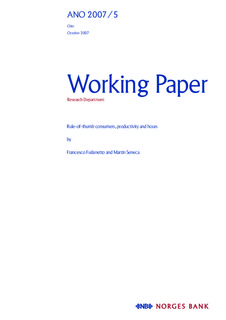| dc.contributor.author | Furlanetto, Francesco | |
| dc.contributor.author | Seneca, Martin | |
| dc.date.accessioned | 2018-05-16T07:20:08Z | |
| dc.date.available | 2018-05-16T07:20:08Z | |
| dc.date.issued | 2007 | |
| dc.identifier.isbn | 978-82-7553-395-9 | |
| dc.identifier.isbn | 978-82-7553-396-6 | |
| dc.identifier.issn | 0801-2504 | |
| dc.identifier.issn | 1502-8143 | |
| dc.identifier.uri | http://hdl.handle.net/11250/2498271 | |
| dc.description.abstract | In this paper we study the transmission mechanisms of productivity shocks in a model with rule-of-thumb consumers. In the literature, this financial friction has been studied only with reference to fiscal shocks. We show that the presence of rule-of-thumb consumers is also very helpful in accounting for recent empirical evidence on productivity shocks. Rule-of-thumb agents, together with nominal and real rigidities, play an important role in reproducing the negative response of hours and the delayed responses of output and consumption after a productivity shock. | nb_NO |
| dc.language.iso | eng | nb_NO |
| dc.publisher | Norges Bank | nb_NO |
| dc.relation.ispartofseries | Working Papers;5/2007 | |
| dc.rights | Attribution-NonCommercial-NoDerivatives 4.0 Internasjonal | * |
| dc.rights.uri | http://creativecommons.org/licenses/by-nc-nd/4.0/deed.no | * |
| dc.subject | JEL: E32 | nb_NO |
| dc.subject | rule-of-thumb consumers | nb_NO |
| dc.subject | productivity shocks | nb_NO |
| dc.subject | nominal rigidities | nb_NO |
| dc.subject | real rigidities | nb_NO |
| dc.title | Rule-Of-Thumb Consumers, Productivity and Hours | nb_NO |
| dc.type | Working paper | nb_NO |
| dc.description.version | publishedVersion | nb_NO |
| dc.subject.nsi | VDP::Samfunnsvitenskap: 200::Økonomi: 210::Samfunnsøkonomi: 212 | nb_NO |
| dc.source.pagenumber | 41 | nb_NO |

